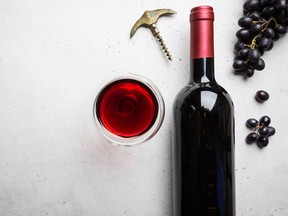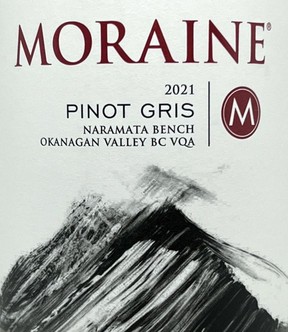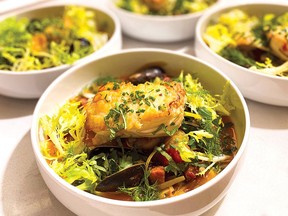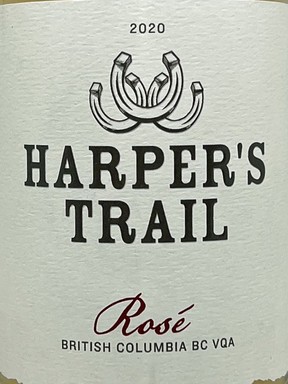Reviews and recommendations are unbiased and products are independently selected. Postmedia may earn an affiliate commission from purchases made through links on this page.
Anthony Gismondi: Improving your wine list doesn’t have to be costly

Anthony Gismondi offers up some ideas on improving the fringes of your wine list

Article content
Will the COVID-19 pandemic change wine lists forever? One can only hope, but it seems improbable unless there is a sea change of thinking among the hospitality business and the people who regulate it.
Advertisement 2
Article content
After two years of sitting at home and having to fend for themselves, I would suggest that consumers have a much better idea of which wines they would like to drink for dinner, but the chances of finding it on a restaurant menu post-pandemic, are slim to none.
We have been through most roadblocks, beginning with the B.C.’s pretend wholesale pricing system as it relates to the global wine business. Add on punishing taxes, two years of COVID restrictions, crazy rents and an ancient business model based on liquor paying for everything in a restaurant, and it’s hard to see how any change is coming soon.
Wine consumption is trending down globally, and the elephant in the room is high prices. Wealthy consumers are drinking better but less, while most British Columbians trying to pay the rent and buy groceries have been forced to trade down, spending more and more for less. It is a painful cycle.
Advertisement 3
Article content
There are no real answers, but what if we look at wine lists as something that could attract the wine drinkers into restaurants, to promote conviviality, neighbourhood dining, eating out more than once a month? Then, maybe we can turn the tide.
What’s clear is that most of us seek a night out and want some comfort with a decent glass of affordable wine. We don’t want a $75 bottle of wine, which tastes like $30 with a base cost of $7 or $8.
Why do so many delicious, inexpensive wines never make it to wine lists? The answer is easy and troubling. The restaurant system thrives on selling you wine you never heard of so that prices can be manipulated. Also, and perhaps more critical, inexpensive wines, no matter the quality, won’t result in a sizable tip for the underpaid server — remember that ancient business model.
Advertisement 4
Article content
For example, In a city awash in seafood selections and a growing number of plant-based eaters, why is it so difficult to list a half dozen classic white wines that promise a great experience and don’t cost an arm and a leg?
Does anybody think wine-by-the-glass at $15 is a deal when you can buy the whole bottle for $15 at retail? Now your choice is to pay $55 because the bottle price is marginally better than by-the-glass — or you order a cocktail — but you still need a real wine in the minimum $70-$90 range for dinner. Add in the tip, and you’ve dropped $150, and you haven’t ordered any food.
If you have been ordering in, you will know the exact scenario involving bottles of wine you want to drink and enhance your evening will set you back $50-$60, and you need only wash your glasses.
Advertisement 5
Article content
I can’t solve the baked-in ancient restaurant business model, but I would appeal to wine list designers to add a few more wines for those who want to dine out but live a modest life on a modest income in one of the most expensive cities in the world. Local repeat customers have to be worth something. They were pretty important during the pandemic.
Here’s what I think you could do to improve the fringes of your wine list, complete with pricing. I’ve taken the liberty of giving you a hefty markup of 2.5 times the wholesale price.
So give us some Albarino, imported or local like Adegas Rosal Albarino, Rias Baixas, Spain at $46.55. Soave is a great seafood wine, and we like Anselmi San Vincenzo for $47.40. New Zealand Pinot Noir with salmon is a winner. Our pick is Mudhouse Pinot Noir, Central Otago, New Zealand, for $52.45.
Advertisement 6
Article content
How about a quality organic red? From the Southern Hemisphere — yes, you can list a Chilean wine — we love the Emiliana Coyam, Colchagua, Chile at $60.75. Locally, you can go with the Clos du Soleil Celestiale, Similkameen Valley for $54.50.
Chardonnay leads all other grapes in sales but is almost extinct on some wine lists, same with Cabernet Sauvignon for the reds — two affordable picks we like are: Meyer Family Chardonnay, Okanagan Valley at $44.20 and Casa Lapostolle Cuvee Alexandre Cabernet Sauvignon, Colchagua, Chile for $57.45.
Today’s suggestions will come in at less than half of these prices for at-home drinkers. Good hunting.
Weekend wine picks

Paul Mas Grenache Noir 2018, Sud de France, France
$14.99 I 88/100
Advertisement 7
Article content
UPC: 03760040423517
This wine hits all the marks for value, and despite the issues of our times, the price remains crazy low. The style is fresh and juicy, lending it broad appeal and the Garrigue of southern France balances the raspberry, black cherry, and brown spices that heat a finish made for barbecue meats or roasted vegetables. So stock up while you can at this price.

Moraine Pinot Gris 2021, Naramata Bench, Okanagan Valley, British Columbia, Canada
$20 I 89/100
UPC: 626990127703
The Moraine Pinot Gris comes off two Naramata Bench sites: Anastasia Estate Vineyard and Dragon Terroir Vineyard. Both locations offer mineral-rich soils and premium exposure to the mid-Okanagan sun. The nose is big-time floral with intense apple blossoms and violets followed by a west stone, mineral, citrus undercurrent and fully ripe sweet pear and lemon balanced with a dusting of lime zest. A wine for the summer patio, and you can serve it with lightly spicy food like a spicy tuna sushi roll. Bonus, it is a perfect 13 per cent alcohol.
Advertisement 8
Article content

Spearhead Pinot Gris Golden Retreat Vineyard 2020, Okanagan Valley, British Columbia, Canada
$20 I 89/100
UPC: 626990441175
Golden Retreat Vineyard is in Summerland, and like Naramata and perhaps the Similkameen, these are the star sites for Pinot Gris. Winemaker Grant Stanley prefers the tighter, sleeker style of Gris, although I find this wine very accommodating in 2020 with its ripe citrus touched with honey and lees. It is all hand-harvested and whole-bunch-pressed, and only 10 per cent of the fruit is fermented in two-year-old French oak barrels adding a touch of texture and weight. In 2021, most of the heft comes from very ripe orchard fruits, giving it a somewhat juicy tropical front end balanced off by a mineral finish. Perfect for more decadent seafood dishes this year. Super value.
Advertisement 9
Article content

Burrowing Owl Syrah 2019, Okanagan Valley, British Columbia, Canada
$35 I 90/100
UPC: 688229004193
The BOV Syrah has never been a shy wine, and 2019 is no different. The meaty, peppery nose mixes with savoury, peppery, sagebrush notes that fire up the heat and oak in the wine. The palate is awash in black raspberry, blackberry and blueberry flavours mixed with more toasted oak and a meaty soy finish. The fruit was picked off two sites in late October: the Burrowing Owl Vineyard (Oliver) and Eva’s Vineyards (Osoyoos). But, for the moment, lamb shoulder is the best friend of this wine or another seven to 10 years in the bottle.

Liquidity Wines Dividend 2019, Okanagan Falls, Okanagan Valley, British Columbia, Canada
Advertisement 10
Article content
$35 I 90/100
UPC: 626990442684
Liquidity is stepping it up under winemaker Amy Paynter, who continues to paint an elegant strip across her wines, making them very approachable in their youth. The blend is 45/40/15 Cabernet Sauvignon, Merlot and Cabernet Franc, aged in French oak. Look for savoury black raspberry and blackcurrant flecked with smoky licorice dusted in chalky tannins. Youthful enough for bison or lamb but elegant sufficient for roast beef.

Recipe match: Pan-roasted B.C. halibut with mussels, chorizo and fennel
It’s halibut season! Celebrate the bounty of the flatfish with this flavourful recipe created by Chef Alex Lavroff from the Pacific Institute of Culinary Arts. Combining fresh halibut filets with savoury chorizo sausage, mussels and more, the simple — and simply delicious — dish is sure to become a seasonal favourite.
Advertisement 11
Article content
Pan-roasted B.C. halibut with mussels, chorizo and fennel
4 x 4 oz (114 g) halibut filets
12 mussels, cleaned
1 piece of dry chorizo sausage, chopped
1 cup (250 mL) crushed tomatoes
3 cloves garlic, finely chopped
1/4 fennel bulb, sliced thinly or shaved on a mandolin, reserve fronds for garnish
1 shallot, finely chopped
1 head frisée or other bitter greens such as endive, radicchio or arugula
1/2 cup (125 mL) chopped fresh herbs such as basil, dill, tarragon, parsley, mint and chives
6 cherry tomatoes, cut in half
3 limes, zest and juice 2 limes and slice the third
1 cup (250 mL) dry white wine
2 cups (500 mL) stock such as chicken, vegetable or fish
6 fingerling potatoes, precooked and chilled
1 leek, chopped
1/4 cup (60 mL) extra virgin olive oil
Advertisement 12
Article content
2 tbsp (30 mL) unsalted butter
Pre-cook fingerling potato ahead of time and chill.
Rinse and clean mussels. Set aside on a bowl of ice.
Heat up a large sauté pan and drizzle olive oil. Deeply sear one side of halibut filets and set aside.
Add 3 tbsp of oil into the pan and heat until very hot. Add chorizo.
Using your palms, smash the cooked fingerling potatoes. Place in pan along with chorizo. Once the chorizo starts to render, the fat will turn orange in the pan. Add garlic, shallot, fennel, cherry tomato, and chopped leeks.
Let all the ingredients sweat together. Then add white wine, stock, and crushed tomatoes. Allow all the ingredients to simmer. Season with salt and pepper.
Add mussels. Then carefully place halibut filets into the broth. Add butter along with the zest and juice of two limes. Place lid on the pan and let everything simmer for about 3 minutes.
Advertisement 13
Article content
Remove from heat. Garnish with reserved fennel fronds, fresh herbs, and a drizzle of remaining olive oil. Garnish with slices of lime. Serve immediately
Serves four.
Recipe match
Pan-roasted B.C. halibut with mussels, chorizo and fennel shouts for a rosé to tame the flavours and stand up to the texture and warmth of this dish

Modest Wines The Eye of the Partridge Pinot Noir Rosé 2021, Similkameen Valley, B.C. $24.99
A Cawston rosé with a spare manner, its stony, dusty Similkameen demeanour with notes of strawberries is made for fish soups.

Harper’s Trail Rosé 2020, Kamloops, British Columbia $19.99
A sleek, dryish, pale pink wine with notes of lime, green raspberry, strawberry and watermelon with a dusting of spice — a soup hunter.
Source: vancouversun.com


